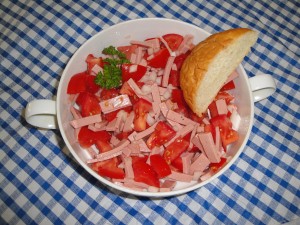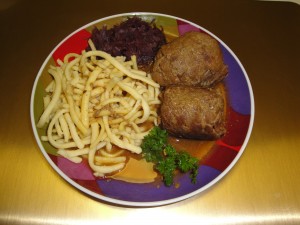What is German Cooking?
the first of 4 articles, see “City foods – Country foods” next.Before we go into Bavarian food let us first establish if there is such a thing as German Cooking.
The answer in short is “yes” and also “no“!
As we already take the word “cuisine” from the French, we think of the French as the top echelon of gourmet foods. We talk about Italian, Chinese, Mexican and even Thai cuisine, but when we talk about German food, it’s simply cooking.
As we look at the history of France we see that the French cuisine actually is a mixture of different nationalities. Let’s start at about 600 BC when the Gallic Celts settled there from the north and also Phoenician and Greek traders had already established trading posts along the Mediterranean coast. Give the Romans a few more years and the area of France was conquered and divided into Roman provinces. Along came the Germanic tribes who chased out the Romans. Here it is said that the French language kind of established itself as a mix of Latin and old German. Also the Vikings with their wide trading network settling in Normandy had influences in the area. All these elements had an influence in what we call “French Cuisine”.
Now let us compare a few dishes, “Liver Pâté” could be called “feine Leberwurst” (fine liver sausage) in German, who invented it? I don’t know. “Roux” (browned flour in butter used to thicken gravies) is called an “Einbrenn” in German, again it is anybodies guess where it came from. Using heavy cream in sauces, like in “Steak au Poivre” (peppered steak or steak with pepper), can also be found in the German “Rahmschnitzel” (cutlet in heavy cream sauce).
There are many dished found in local cooking which are known under different names all over Europe. Here the world famous “Sauerkraut” comes to mind which found it’s way into the Polish and Slavic cooking as “Kapusta”. The Polish luncheon meat Krakowskaw is the same as the Krakauer in German and refers to it’s origin in the city of Krakow, Poland.
So you see, that any “European Cuisine” is actually a mixture of all the different European entities together. I believe, when going through a list of French recipes, you can find an equivalent of them somewhere in Europe and we can argue all day long about who originated them.
One thing the French did well was refine the way to dine, with small portion, multiple-course meals which take hours to enjoy.
So here it is; the German cooking is actually a mixture of dishes. Some started locally, others are from all over Europe and nowadays even the whole world and are often adapted to regional ingredients and tastes.
And herewith we say “Guten Appetit”, or “Good Appetite”
(by the way “appetite” comes from the Latin meaning “the desire for food”)



